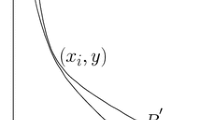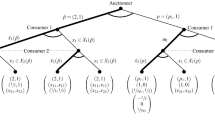Abstract
This paper studies an economy whose agents perceive their consumption possibilities subjectively, and whose preferences are defined on what they subjectively experience, rather than on those alternatives that are objectively present. The model of agents’ perceptions is based on intuitionistic logic. Roughly, this means that agents reason constructively: a solution to a problem exists only if there is a construction by which the problem can be solved. The theorems that can be proved determine how an agent perceives a set of alternatives. A dual model relates perceived alternatives to a shared language, which the agents use in trading. So perceptions relate objective alternatives to an agent’s subjective view of them, and reporting dually relates an agent’s subjective world to a shared language. It turns out that an appropriately modified notion of competitive equilibrium always exists. However, in contrast with standard results in economic theory, competitive equilibrium need not be efficient.
Similar content being viewed by others
References
Ahn, R. M. C. (2000). Agents, objects, and events: A computational approach to knowledge, observation, and communication. Ph.D. thesis, Technische Universitiet Eindhoven.
Allen B., Thisse J. (1992) Price equilibria in pure strategies for homogeneous oligopoly. Journal of Economics and Management Strategy 1(1): 63–81
Anderlini L., Felli L. (1994) Incomplete written contracts: Undescribable states of nature. Quarterly Journal of Economics 109(4): 1085–1124
Berge C. (1963) Topological spaces. Oliver and Boyd, Edinburgh
Bridges D. S. (1982) Preferences and utility: A constructive development. Journal of Mathematical Economics 9(1–2): 165–185
Bridges D. S. (1983) Numerical representation of intransitive preferences on a countable set. Journal of Economic Theory 30(1): 213–217
Bridges D. S. (1992) The construction of a continuous demand function for uniformly rotund preferences. Journal of Mathematical Economics 21(3): 217–227
Bridges, D. S. (1999). Constructive methods in mathematical economics. Journal of Economics Supplement, 1–21.
Bridges D.S., Vîţă L.S. (2006). Techniques of constructive analysis, universitext. New York: Springer.
Fourman, M. P., & Grayson, R. J. (1982). Formal spaces. In: A. S. Troelstra & D. van Dalen (Eds.) The L. E. J. Brouwer Centenary Symposium, pp. 107–122.
Harris M. (1987) Dynamic economic analysis. Oxford University Press, New York
Heyting A. (1956) Intuitionism: An introduction. North-Holland, Amsterdam
Lang S. (2000) Algebra, 3rd edn. Springer-Verlag, New York
Lawvere F. W., Schanuel S. H. (1997) Conceptual mathematics: A first introduction to categories. Cambridge University Press, New York
Luce R. D. (1956) Semiorders and a theory of utility discrimination. Econometrica 24(2): 178–191
Martino, E. (1982). Creative subject and the bar theorem. In: A. S. Troelstra & D. van Dalen (Eds.) The L. E. J. Brouwer Centenary Symposium. North-Holland, pp. 311–318.
Martino, E. (1983). Connection between the ‘Principle of inductive evidence’ and the bar theorem. In: Proceedings of the Koninklijke Nederlandse Akademie van Wetenschappen, Vol. 86(3) of A. pp. 325–328.
McKinsey J. C. C., Tarski A. (1948) Some theorems about the sentential calculi of Lews and Heyting’. Journal of Symbolic Logic 13: 1–15
Nachbar J. H., Zame W. R. (1996) Non-computable strategies and discounted repeated games. Economic Theory 8(1): 103–122
Negri S. (1996) Stone bases, alias the constructive content of stone representation. In: Ursini A., Aglianó P. (eds) Logic and algebra. Dekker, New York, pp 617–636
Negri S. (2002) Continuous domains as formal spaces. Mathematical Structures in Computer Science 12: 19–52
Negri S., Soravia D. (1999) The continuum as a formal space. Archive for Mathematical Logic 38: 423–447
Richter M. K., Wong K.-C. (1999) Computable preferences and utility. Journal of Mathematical Economics 32: 339–354
Sambin G. (1987) Formal spaces—a first communication. In: Skordev D. G. (eds) Mathematical logic and its applications. Plenum, New York, pp 187–204
Sambin, G. (2001). The basic picture, a structure for topology (the basic picture, I). Technical report, University of Padua Department of Pure and Applied Mathematics.
Sambin G. (2003) Some points in formal topology. Theoretical Computer Science 305(1–3): 347–408
Sambin G. (2010) The basic picture: Structures for constructive topology, Oxford logic guides. Oxford University Press, New York
Sambin, G., & Gebellato, S. (1998). A preview of the basic picture: A new perspective on formal topology. In: Types and Proofs for Programs, Vol. 1657 of Lecture Notes in Computer Science. Springer-Verlag, pp. 194–207.
Scott D. S. (1968) Extending the topological interpretation to intuitionistic analysis. In: van Dalen D., Dijkman J. G., Kleene S. C., Troelstra A. S. (eds) Logic and foundations of mathematics. Wolters-Noordhoff Publishing, Groningen, pp 194–210
Stecher J. D. (2008a) Existence of approximate social welfare. Social Choice and Welfare 30(1): 43–56
Stecher, J. D. (2008b). Subjective information in decision making and communication. In: M. Abdellaoui & J. D. Hey (Eds.) Advances in decision making under risk and uncertainty, Springer Theory and Decision Library. Springer-Verlag, Chapt. 4, pp. 47–60.
van Benthem J. (2009) The information in intuitionistic logic. Synthese 167(2): 251–270
Vickers S. J. (1988) Topology via logic, No. 5 in Cambridge tracts in theoretical computer science. Cambridge University Press, New York
Walicki, M., Wolter, U., & Stecher, J. (2006). The choice of standards for a reporting language. In S. S. Goncharov, H. Ono, & R. G. Downey (Eds.) Mathematical logic in Asia: Proceedings of the ninth Asian logic conference, World Scientific, pp. 277–287
Author information
Authors and Affiliations
Corresponding author
Rights and permissions
About this article
Cite this article
Stecher, J.D. Competitive equilibrium with intuitionistic agents. Synthese 181 (Suppl 1), 49–63 (2011). https://doi.org/10.1007/s11229-010-9762-y
Received:
Accepted:
Published:
Issue Date:
DOI: https://doi.org/10.1007/s11229-010-9762-y




